2015 NISSAN LEAF navigation
[x] Cancel search: navigationPage 247 of 412

AUTOMATIC CLIMATE CONTROL
(MODELS WITH NAVIGATION
SYSTEM)
1. Temperature control button
2. HEAT button
3. Climate Ctrl. Timer indicator4.
(front defroster) button
5.
(fan speed control) button
6.
(rear window defroster) button (See
“Rear window and outside mirror defroster
switch” in the “Instruments and controls”
section.)
7.
(intake air control) button 8. A/C-Heater ON·OFF button
9. AUTO climate control ON button
10. MODE (manual air flow control) button
11. A/C (air conditioner) ON·OFF button
Automatic operation (AUTO)
The AUTO mode may be used year-round as the
system automatically controls constant tempera-
ture, air flow distribution and fan speed.
To turn off the climate control, press the A/C-
Heater ON·OFF button.
The same operating mode (Heater or A/C) that
was active when the system is turned off is active
when system is turned back on.
While operating the climate control in the AUTO
mode, selecting any other climate control button
de-activates the AUTO mode and activates
manual mode.
Cooling and/or dehumidified heating:
The dehumidified heating mode can be used to
keep the windows from fogging. In this mode, the
heat pump compressor is used in A/C mode for
dehumidifying the air instead of heating it. The
PTC heater is also used in conjunction to heat the
air. This mode will increase energy consumption
and therefore reduce range.
4-20Display screen, heater, air conditioner, audio and phone systems
Page 252 of 412
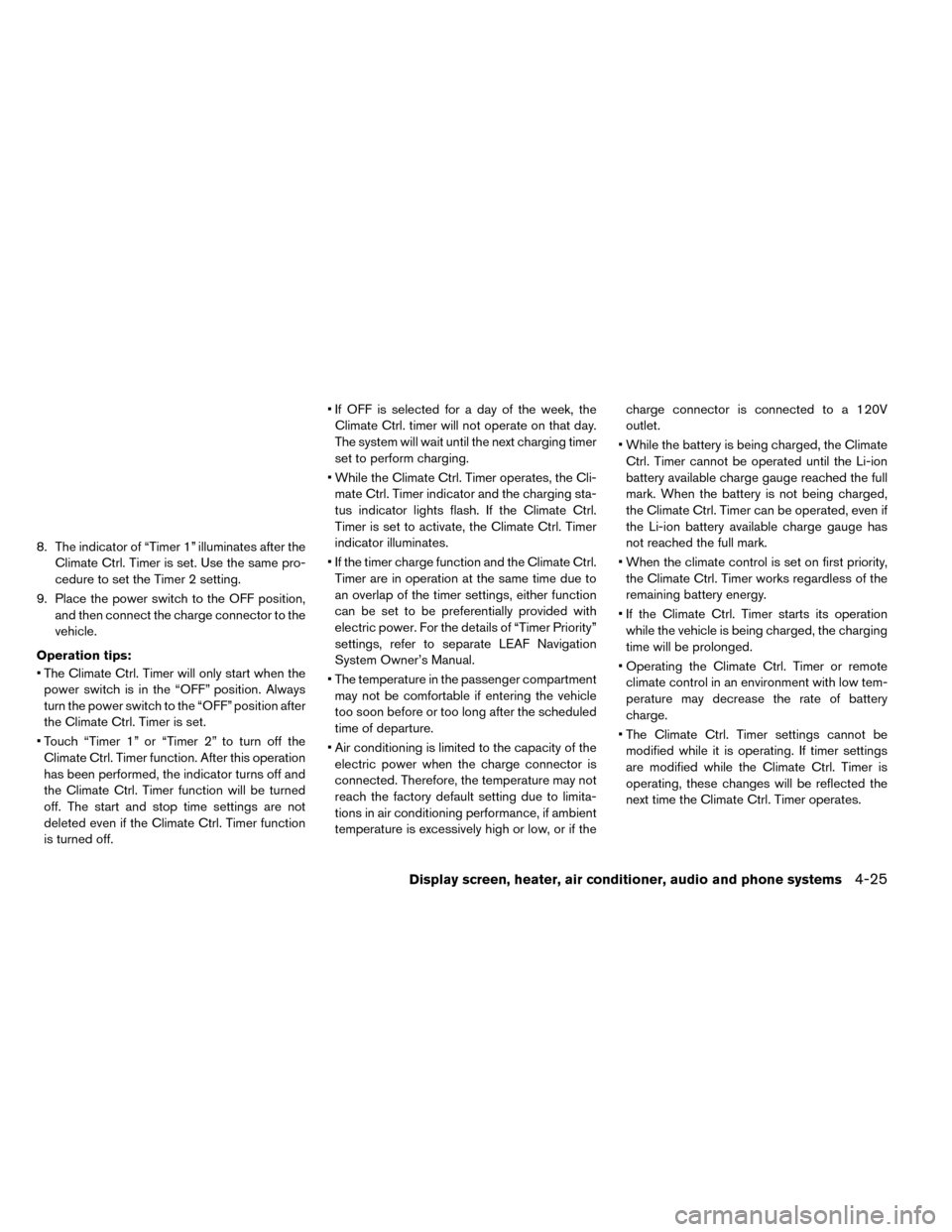
8. The indicator of “Timer 1” illuminates after theClimate Ctrl. Timer is set. Use the same pro-
cedure to set the Timer 2 setting.
9. Place the power switch to the OFF position, and then connect the charge connector to the
vehicle.
Operation tips:
• The Climate Ctrl. Timer will only start when the power switch is in the “OFF” position. Always
turn the power switch to the “OFF” position after
the Climate Ctrl. Timer is set.
• Touch “Timer 1” or “Timer 2” to turn off the Climate Ctrl. Timer function. After this operation
has been performed, the indicator turns off and
the Climate Ctrl. Timer function will be turned
off. The start and stop time settings are not
deleted even if the Climate Ctrl. Timer function
is turned off. • If OFF is selected for a day of the week, the
Climate Ctrl. timer will not operate on that day.
The system will wait until the next charging timer
set to perform charging.
• While the Climate Ctrl. Timer operates, the Cli- mate Ctrl. Timer indicator and the charging sta-
tus indicator lights flash. If the Climate Ctrl.
Timer is set to activate, the Climate Ctrl. Timer
indicator illuminates.
• If the timer charge function and the Climate Ctrl. Timer are in operation at the same time due to
an overlap of the timer settings, either function
can be set to be preferentially provided with
electric power. For the details of “Timer Priority”
settings, refer to separate LEAF Navigation
System Owner’s Manual.
• The temperature in the passenger compartment may not be comfortable if entering the vehicle
too soon before or too long after the scheduled
time of departure.
• Air conditioning is limited to the capacity of the electric power when the charge connector is
connected. Therefore, the temperature may not
reach the factory default setting due to limita-
tions in air conditioning performance, if ambient
temperature is excessively high or low, or if the charge connector is connected to a 120V
outlet.
• While the battery is being charged, the Climate Ctrl. Timer cannot be operated until the Li-ion
battery available charge gauge reached the full
mark. When the battery is not being charged,
the Climate Ctrl. Timer can be operated, even if
the Li-ion battery available charge gauge has
not reached the full mark.
• When the climate control is set on first priority, the Climate Ctrl. Timer works regardless of the
remaining battery energy.
• If the Climate Ctrl. Timer starts its operation while the vehicle is being charged, the charging
time will be prolonged.
• Operating the Climate Ctrl. Timer or remote climate control in an environment with low tem-
perature may decrease the rate of battery
charge.
• The Climate Ctrl. Timer settings cannot be modified while it is operating. If timer settings
are modified while the Climate Ctrl. Timer is
operating, these changes will be reflected the
next time the Climate Ctrl. Timer operates.
Display screen, heater, air conditioner, audio and phone systems4-25
Page 255 of 412

Note
•The temperature in the passenger com-
partment may not be comfortable if enter-
ing the vehicle too soon before or too long
after the scheduled time of departure.
• Air conditioning is limited to the capacity
of the electric power when the charge
connector is connected. Therefore, the
temperature may not reach the set tem-
perature due to limitations in air condi-
tioning performance, if ambient tempera-
ture is excessively high or low, or if the
charge connector is connected to a 120 V
plug outlet.
• The Climate Ctrl. Timer operates the cli-
mate control function so that a comfort-
able temperature is provided in the pas-
senger compartment at the scheduled
time of departure. The climate control is
set to stop at the scheduled time of
departure.
RADIO
Push the power switch to the ACC or ON posi-
tion and press the radio band select button to
turn on the radio. If you listen to the radio while
the READY to drive indicator light is off, the
power switch should be pushed to the ACC
position.
Radio reception is affected by station signal
strength, distance from radio transmitter, build-
ings, bridges, mountains and other external influ-
ences. Intermittent changes in reception quality
normally are caused by these external influences.
Using a cellular phone in or near the vehicle
may influence radio reception quality.
Radio reception
Your NISSAN radio system is equipped with
state-of-the-art electronic circuits to enhance ra-
dio reception. These circuits are designed to
extend reception range, and to enhance the qual-
ity of that reception. However, there are some general characteristics
of both FM and AM radio signals that can affect
radio reception quality in a moving vehicle, even
when the finest equipment is used. These char-
acteristics are completely normal in a given re-
ception area and do not indicate any malfunction
in your NISSAN radio system.
Reception conditions will constantly change be-
cause of vehicle movement. Buildings, terrain,
signal distance and interference from other ve-
hicles can work against ideal reception. De-
scribed below are some of the factors that can
affect your radio reception.
Some cellular phones or other devices may
cause interference or a buzzing noise to come
from the audio system speakers. Storing the de-
vice in a different location may reduce or elimi-
nate the noise.
AUDIO SYSTEM (MODELS WITHOUT
NAVIGATION SYSTEM)
4-28Display screen, heater, air conditioner, audio and phone systems
Page 263 of 412
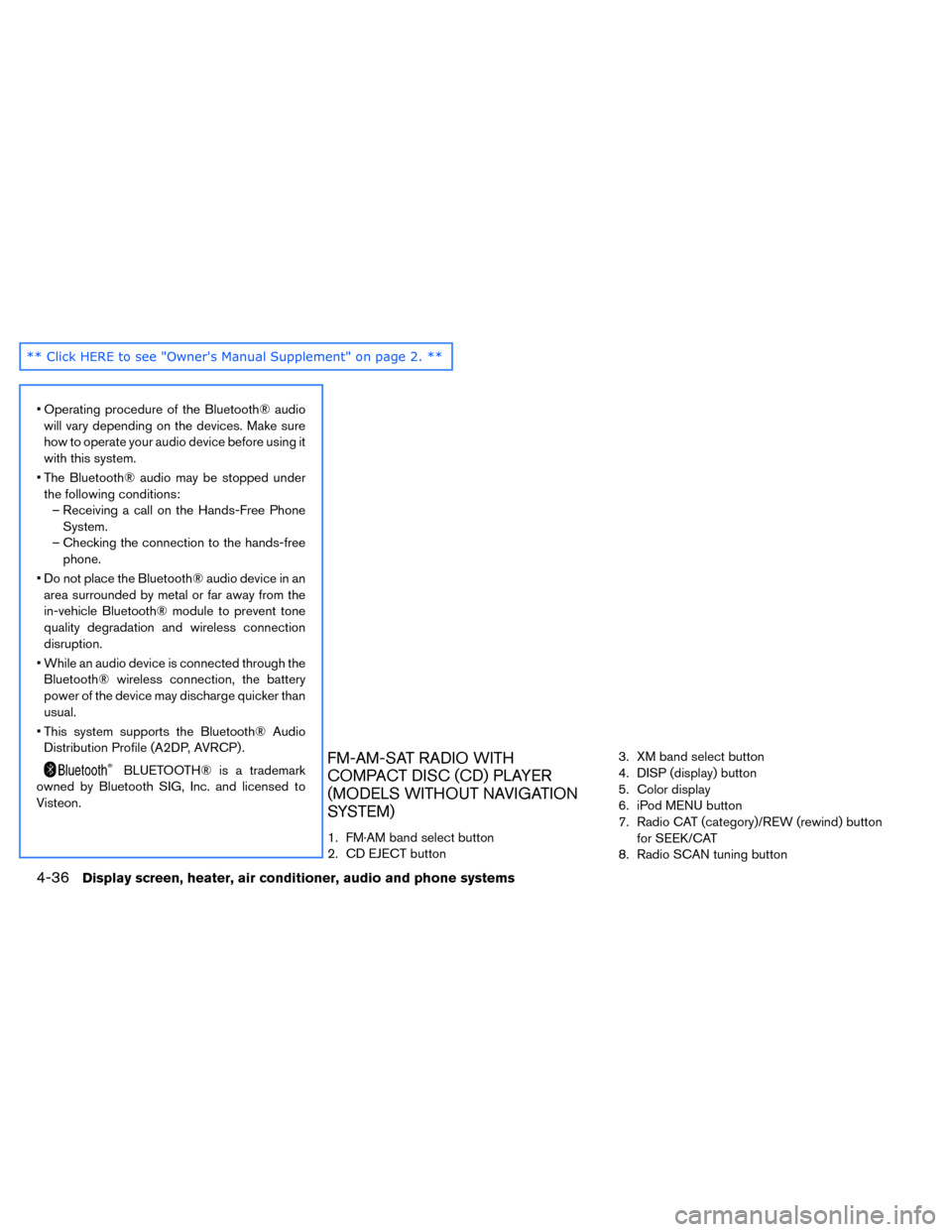
• Operating procedure of the Bluetooth® audiowill vary depending on the devices. Make sure
how to operate your audio device before using it
with this system.
• The Bluetooth® audio may be stopped under the following conditions: – Receiving a call on the Hands-Free Phone System.
– Checking the connection to the hands-free phone.
• Do not place the Bluetooth® audio device in an area surrounded by metal or far away from the
in-vehicle Bluetooth® module to prevent tone
quality degradation and wireless connection
disruption.
• While an audio device is connected through the Bluetooth® wireless connection, the battery
power of the device may discharge quicker than
usual.
• This system supports the Bluetooth® Audio Distribution Profile (A2DP, AVRCP) .
BLUETOOTH® is a trademark
owned by Bluetooth SIG, Inc. and licensed to
Visteon.FM-AM-SAT RADIO WITH
COMPACT DISC (CD) PLAYER
(MODELS WITHOUT NAVIGATION
SYSTEM)
1. FM·AM band select button
2. CD EJECT button 3. XM band select button
4. DISP (display) button
5. Color display
6. iPod MENU button
7. Radio CAT (category)/REW (rewind) button
for SEEK/CAT
8. Radio SCAN tuning button
4-36Display screen, heater, air conditioner, audio and phone systems
Page 274 of 412
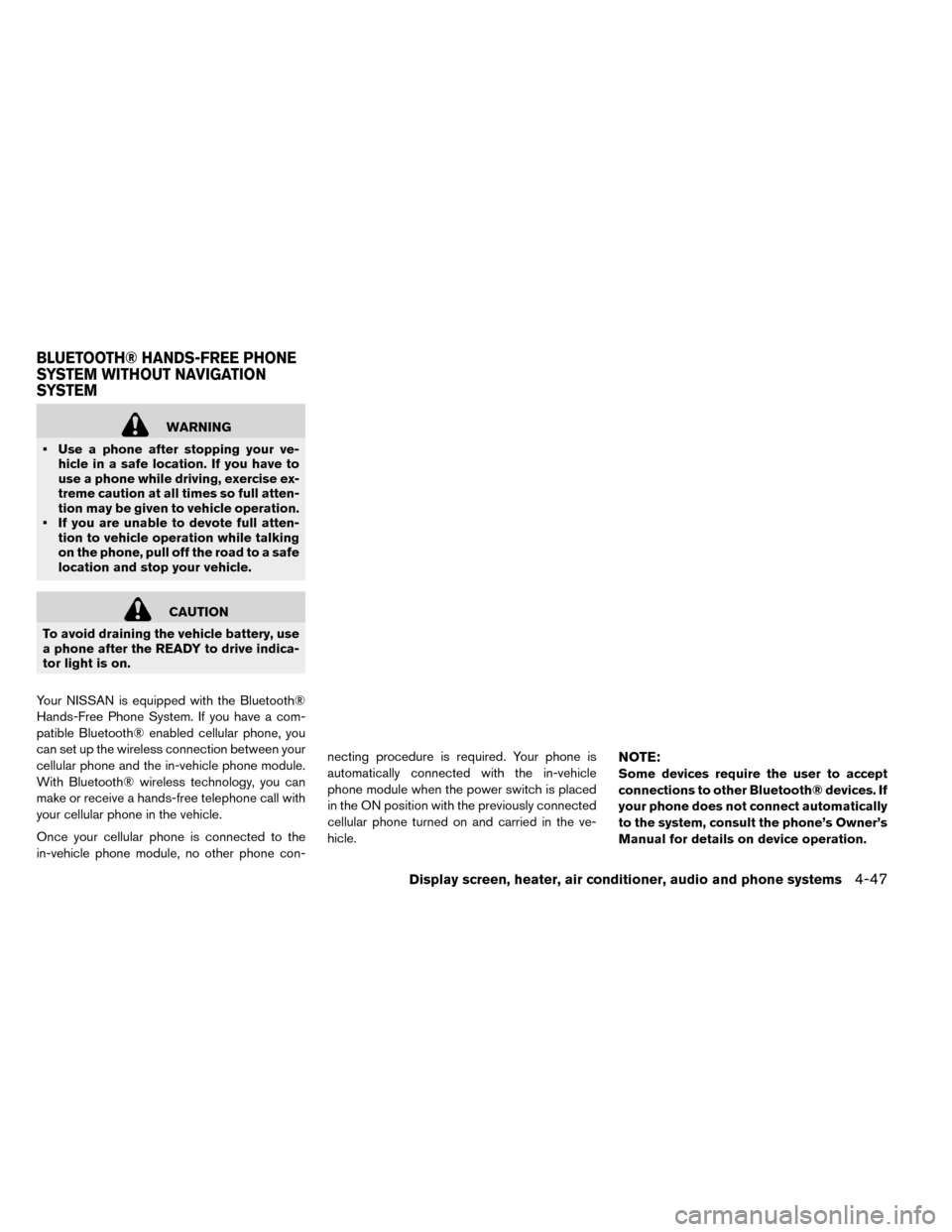
WARNING
• Use a phone after stopping your ve- hicle in a safe location. If you have to
use a phone while driving, exercise ex-
treme caution at all times so full atten-
tion may be given to vehicle operation.
• If you are unable to devote full atten- tion to vehicle operation while talking
on the phone, pull off the road to a safe
location and stop your vehicle.
CAUTION
To avoid draining the vehicle battery, use
a phone after the READY to drive indica-
tor light is on.
Your NISSAN is equipped with the Bluetooth®
Hands-Free Phone System. If you have a com-
patible Bluetooth® enabled cellular phone, you
can set up the wireless connection between your
cellular phone and the in-vehicle phone module.
With Bluetooth® wireless technology, you can
make or receive a hands-free telephone call with
your cellular phone in the vehicle.
Once your cellular phone is connected to the
in-vehicle phone module, no other phone con- necting procedure is required. Your phone is
automatically connected with the in-vehicle
phone module when the power switch is placed
in the ON position with the previously connected
cellular phone turned on and carried in the ve-
hicle.
NOTE:
Some devices require the user to accept
connections to other Bluetooth® devices. If
your phone does not connect automatically
to the system, consult the phone’s Owner’s
Manual for details on device operation.
BLUETOOTH® HANDS-FREE PHONE
SYSTEM WITHOUT NAVIGATION
SYSTEM
Display screen, heater, air conditioner, audio and phone systems4-47
Page 312 of 412
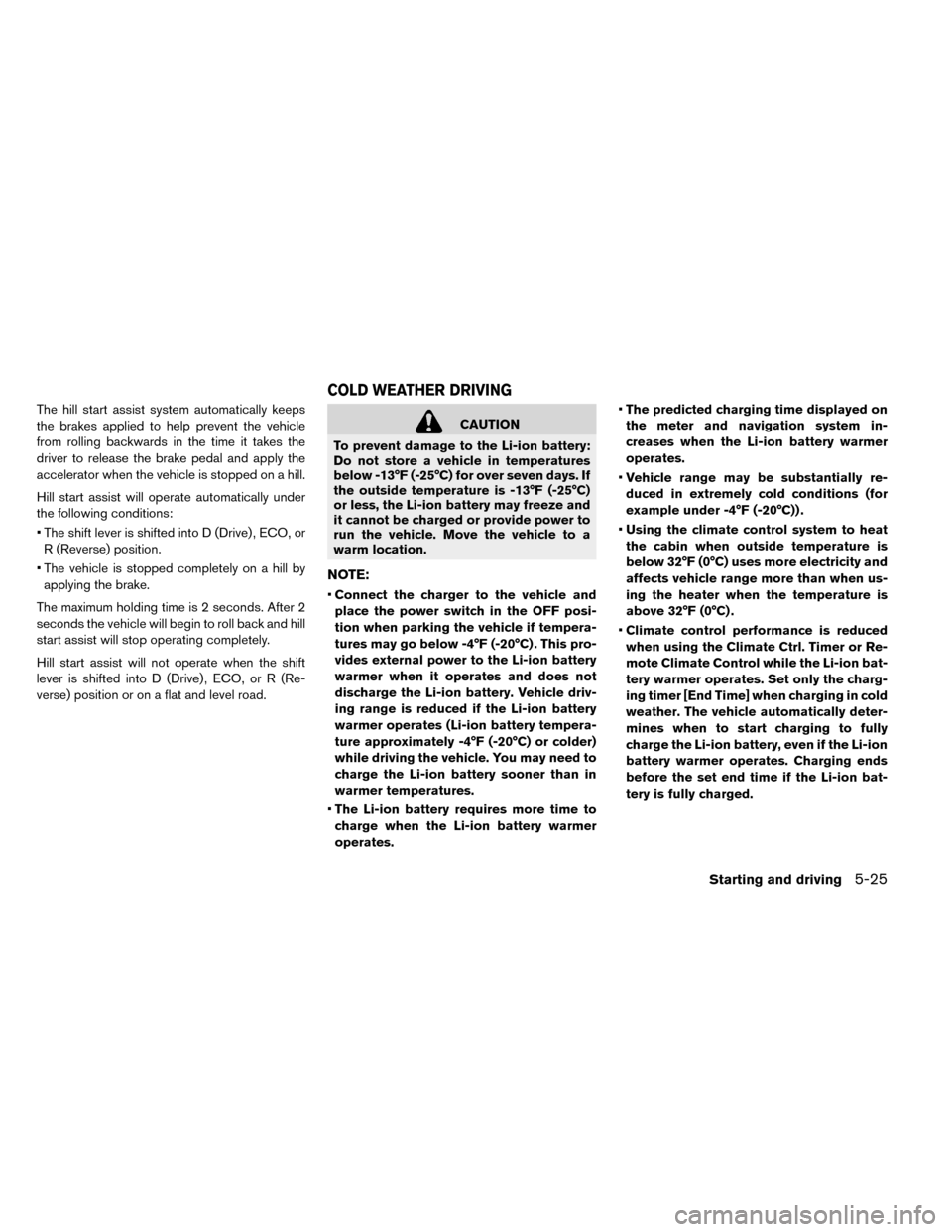
The hill start assist system automatically keeps
the brakes applied to help prevent the vehicle
from rolling backwards in the time it takes the
driver to release the brake pedal and apply the
accelerator when the vehicle is stopped on a hill.
Hill start assist will operate automatically under
the following conditions:
• The shift lever is shifted into D (Drive) , ECO, orR (Reverse) position.
• The vehicle is stopped completely on a hill by applying the brake.
The maximum holding time is 2 seconds. After 2
seconds the vehicle will begin to roll back and hill
start assist will stop operating completely.
Hill start assist will not operate when the shift
lever is shifted into D (Drive) , ECO, or R (Re-
verse) position or on a flat and level road.CAUTION
To prevent damage to the Li-ion battery:
Do not store a vehicle in temperatures
below -13°F (-25°C) for over seven days. If
the outside temperature is -13°F (-25°C)
or less, the Li-ion battery may freeze and
it cannot be charged or provide power to
run the vehicle. Move the vehicle to a
warm location.
NOTE:
• Connect the charger to the vehicle and
place the power switch in the OFF posi-
tion when parking the vehicle if tempera-
tures may go below -4°F (-20°C) . This pro-
vides external power to the Li-ion battery
warmer when it operates and does not
discharge the Li-ion battery. Vehicle driv-
ing range is reduced if the Li-ion battery
warmer operates (Li-ion battery tempera-
ture approximately -4°F (-20°C) or colder)
while driving the vehicle. You may need to
charge the Li-ion battery sooner than in
warmer temperatures.
• The Li-ion battery requires more time to
charge when the Li-ion battery warmer
operates. •
The predicted charging time displayed on
the meter and navigation system in-
creases when the Li-ion battery warmer
operates.
• Vehicle range may be substantially re-
duced in extremely cold conditions (for
example under -4°F (-20°C)) .
• Using the climate control system to heat
the cabin when outside temperature is
below 32°F (0°C) uses more electricity and
affects vehicle range more than when us-
ing the heater when the temperature is
above 32°F (0°C) .
• Climate control performance is reduced
when using the Climate Ctrl. Timer or Re-
mote Climate Control while the Li-ion bat-
tery warmer operates. Set only the charg-
ing timer [End Time] when charging in cold
weather. The vehicle automatically deter-
mines when to start charging to fully
charge the Li-ion battery, even if the Li-ion
battery warmer operates. Charging ends
before the set end time if the Li-ion bat-
tery is fully charged.
COLD WEATHER DRIVING
Starting and driving5-25
Page 391 of 412
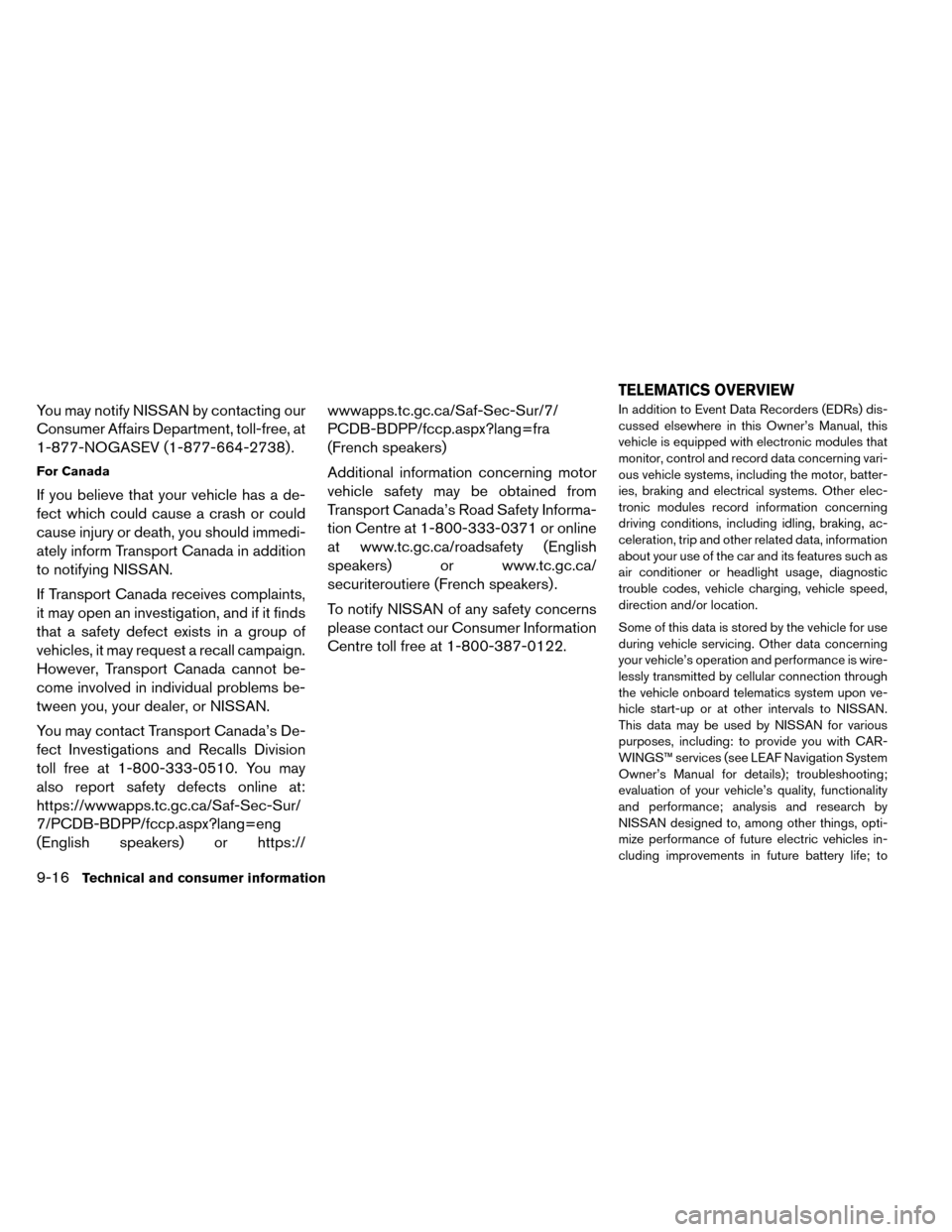
You may notify NISSAN by contacting our
Consumer Affairs Department, toll-free, at
1-877-NOGASEV (1-877-664-2738) .
For Canada
If you believe that your vehicle has a de-
fect which could cause a crash or could
cause injury or death, you should immedi-
ately inform Transport Canada in addition
to notifying NISSAN.
If Transport Canada receives complaints,
it may open an investigation, and if it finds
that a safety defect exists in a group of
vehicles, it may request a recall campaign.
However, Transport Canada cannot be-
come involved in individual problems be-
tween you, your dealer, or NISSAN.
You may contact Transport Canada’s De-
fect Investigations and Recalls Division
toll free at 1-800-333-0510. You may
also report safety defects online at:
https://wwwapps.tc.gc.ca/Saf-Sec-Sur/
7/PCDB-BDPP/fccp.aspx?lang=eng
(English speakers) or https://wwwapps.tc.gc.ca/Saf-Sec-Sur/7/
PCDB-BDPP/fccp.aspx?lang=fra
(French speakers)
Additional information concerning motor
vehicle safety may be obtained from
Transport Canada’s Road Safety Informa-
tion Centre at 1-800-333-0371 or online
at www.tc.gc.ca/roadsafety (English
speakers) or www.tc.gc.ca/
securiteroutiere (French speakers) .
To notify NISSAN of any safety concerns
please contact our Consumer Information
Centre toll free at 1-800-387-0122.
In addition to Event Data Recorders (EDRs) dis-
cussed elsewhere in this Owner’s Manual, this
vehicle is equipped with electronic modules that
monitor, control and record data concerning vari-
ous vehicle systems, including the motor, batter-
ies, braking and electrical systems. Other elec-
tronic modules record information concerning
driving conditions, including idling, braking, ac-
celeration, trip and other related data, information
about your use of the car and its features such as
air conditioner or headlight usage, diagnostic
trouble codes, vehicle charging, vehicle speed,
direction and/or location.
Some of this data is stored by the vehicle for use
during vehicle servicing. Other data concerning
your vehicle’s operation and performance is wire-
lessly transmitted by cellular connection through
the vehicle onboard telematics system upon ve-
hicle start-up or at other intervals to NISSAN.
This data may be used by NISSAN for various
purposes, including: to provide you with CAR-
WINGS™ services (see LEAF Navigation System
Owner’s Manual for details); troubleshooting;
evaluation of your vehicle’s quality, functionality
and performance; analysis and research by
NISSAN designed to, among other things, opti-
mize performance of future electric vehicles in-
cluding improvements in future battery life; to
TELEMATICS OVERVIEW
9-16Technical and consumer information
Page 392 of 412
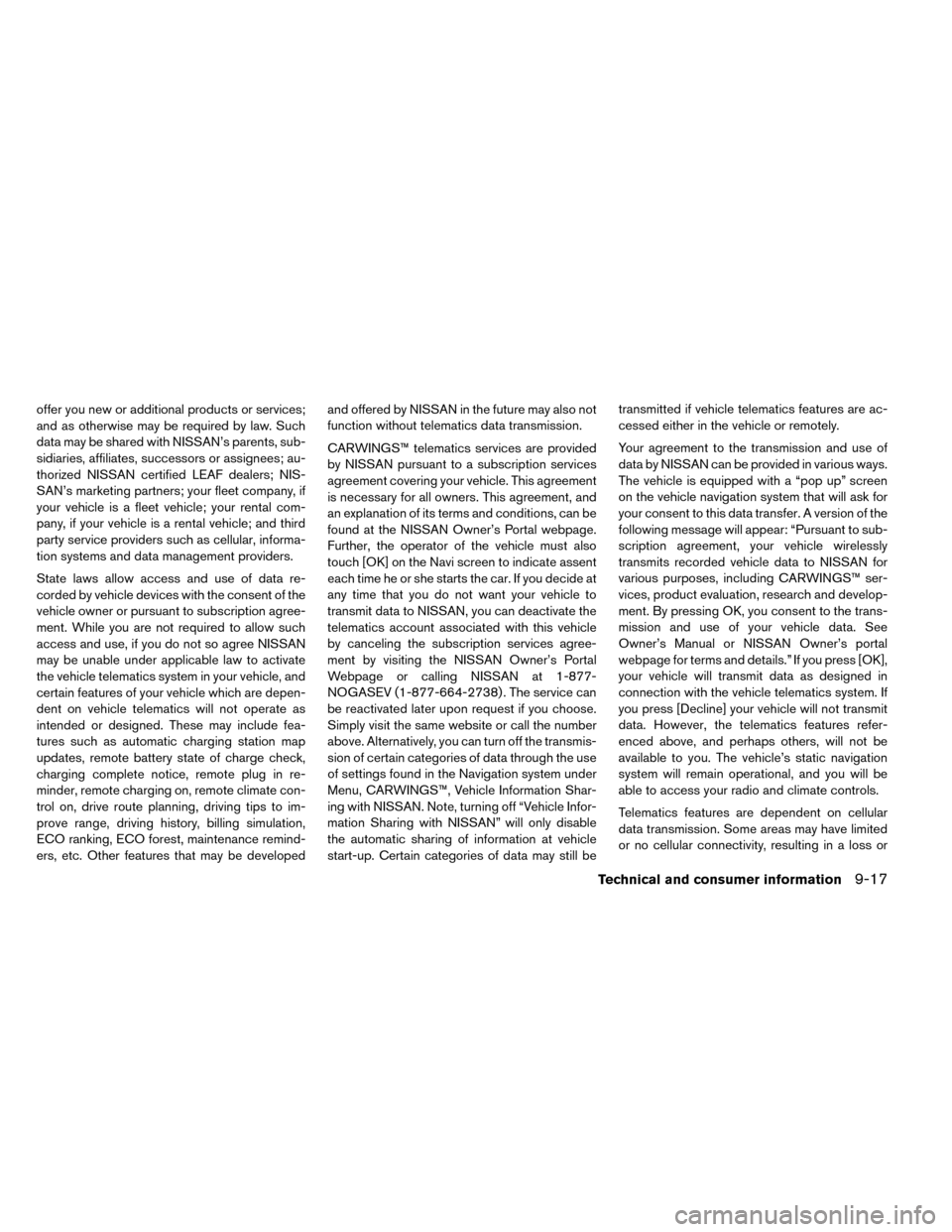
offer you new or additional products or services;
and as otherwise may be required by law. Such
data may be shared with NISSAN’s parents, sub-
sidiaries, affiliates, successors or assignees; au-
thorized NISSAN certified LEAF dealers; NIS-
SAN’s marketing partners; your fleet company, if
your vehicle is a fleet vehicle; your rental com-
pany, if your vehicle is a rental vehicle; and third
party service providers such as cellular, informa-
tion systems and data management providers.
State laws allow access and use of data re-
corded by vehicle devices with the consent of the
vehicle owner or pursuant to subscription agree-
ment. While you are not required to allow such
access and use, if you do not so agree NISSAN
may be unable under applicable law to activate
the vehicle telematics system in your vehicle, and
certain features of your vehicle which are depen-
dent on vehicle telematics will not operate as
intended or designed. These may include fea-
tures such as automatic charging station map
updates, remote battery state of charge check,
charging complete notice, remote plug in re-
minder, remote charging on, remote climate con-
trol on, drive route planning, driving tips to im-
prove range, driving history, billing simulation,
ECO ranking, ECO forest, maintenance remind-
ers, etc. Other features that may be developedand offered by NISSAN in the future may also not
function without telematics data transmission.
CARWINGS™ telematics services are provided
by NISSAN pursuant to a subscription services
agreement covering your vehicle. This agreement
is necessary for all owners. This agreement, and
an explanation of its terms and conditions, can be
found at the NISSAN Owner’s Portal webpage.
Further, the operator of the vehicle must also
touch [OK] on the Navi screen to indicate assent
each time he or she starts the car. If you decide at
any time that you do not want your vehicle to
transmit data to NISSAN, you can deactivate the
telematics account associated with this vehicle
by canceling the subscription services agree-
ment by visiting the NISSAN Owner’s Portal
Webpage or calling NISSAN at 1-877-
NOGASEV (1-877-664-2738) . The service can
be reactivated later upon request if you choose.
Simply visit the same website or call the number
above. Alternatively, you can turn off the transmis-
sion of certain categories of data through the use
of settings found in the Navigation system under
Menu, CARWINGS™, Vehicle Information Shar-
ing with NISSAN. Note, turning off “Vehicle Infor-
mation Sharing with NISSAN” will only disable
the automatic sharing of information at vehicle
start-up. Certain categories of data may still betransmitted if vehicle telematics features are ac-
cessed either in the vehicle or remotely.
Your agreement to the transmission and use of
data by NISSAN can be provided in various ways.
The vehicle is equipped with a “pop up” screen
on the vehicle navigation system that will ask for
your consent to this data transfer. A version of the
following message will appear: “Pursuant to sub-
scription agreement, your vehicle wirelessly
transmits recorded vehicle data to NISSAN for
various purposes, including CARWINGS™ ser-
vices, product evaluation, research and develop-
ment. By pressing OK, you consent to the trans-
mission and use of your vehicle data. See
Owner’s Manual or NISSAN Owner’s portal
webpage for terms and details.” If you press [OK],
your vehicle will transmit data as designed in
connection with the vehicle telematics system. If
you press [Decline] your vehicle will not transmit
data. However, the telematics features refer-
enced above, and perhaps others, will not be
available to you. The vehicle’s static navigation
system will remain operational, and you will be
able to access your radio and climate controls.
Telematics features are dependent on cellular
data transmission. Some areas may have limited
or no cellular connectivity, resulting in a loss or
Technical and consumer information9-17